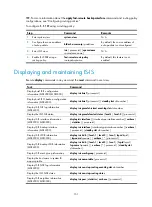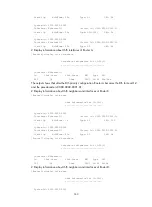
146
Step Command
Remarks
2.
Enter IS-IS view.
isis
[
process-id
] [
vpn-instance
vpn-instance-name
]
N/A
3.
Enable the logging of
neighbor state changes.
log-peer-change
By default, the logging of
neighbor state changes is
enabled.
Enabling IS-IS ISPF
When the network topology changes, Incremental Shortest Path First (ISPF) computes only the affected
part of the SPT, instead of the entire SPT.
To enable IS-IS ISPF:
Step Command
Remarks
1.
Enter system view.
system-view
N/A
2.
Enter IS-IS view.
isis
[
process-id
] [
vpn-instance
vpn-instance-name
] N/A
3.
Enable IS-IS ISPF.
ispf enable
By default, IS-IS is disabled.
Configuring IS-IS network management
This task involves the following configurations:
•
Bind an IS-IS process to MIB so that you can use network management software to manage the
specified IS-IS process.
•
Enable IS-IS notifications to report important events.
Notifications are delivered to the SNMP module, which outputs the notifications according to the
configured output rules. For more information about SNMP notifications, see
Network Management and
Monitoring Configuration Guide
.
To configure IS-IS network management:
Step Command
Remarks
1.
Enter system view.
system-view
N/A
2.
Bind MIB to an IS-IS
process.
isis mib-binding
process-id
By default, MIB is bound to the IS-IS
process with the smallest process
ID.
3.
Enable IS-IS
notification sending.
snmp-agent trap enable isis
[
adjacency-state-change
|
area-mismatch
|
authentication
|
authentication-type
|
buffsize-mismatch
|
id-length-mismatch
|
lsdboverload-state-change
|
lsp-corrupt
|
lsp-parse-error
|
lsp-size-exceeded
|
manual-address-drop
|
max-seq-exceeded
|
maxarea-mismatch
|
own-lsp-purge
|
protocol-support
|
rejected-adjacency
|
skip-sequence-number
|
version-skew
] *
By default, IS-IS notification
sending is enabled.






























